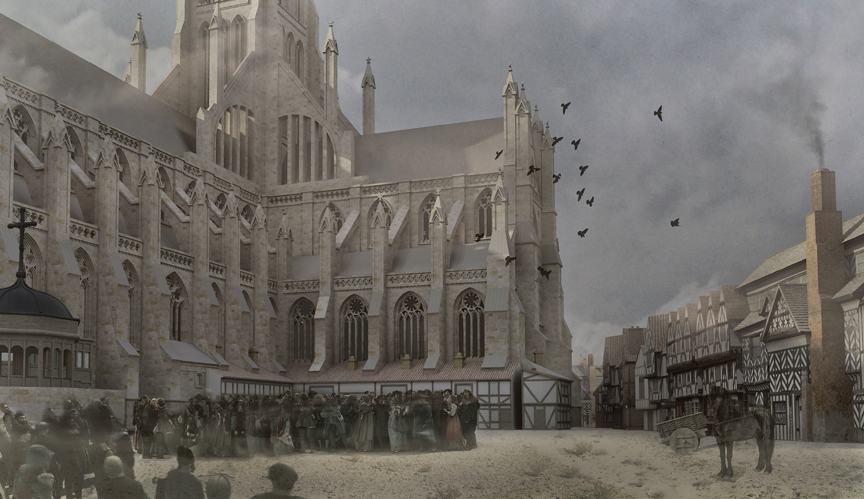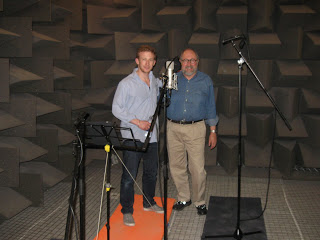
Matthew Azevedo – mazevedo@acentech.com
Ben Markham – bmarkham@acentech.com
Acentech
33 Moulton St.
Cambridge, MA 02138
John N. Wall – jnwall@ncsu.edu
NC State University
Raleigh, North Carolina 27695-8105
Popular version of paper 5aAAa5
Presented Friday morning, June 7, 2013
ICA 2013 Montreal
Archaeology is most commonly associated with studying the material relics of times long past: the art, architecture, tools, and bones of our distant ancestors. A new branch of archaeological study, acoustical archaeology, seeks to explore the sounds of earlier times and to make these sounds available to modern listeners. Several recent acoustical archaeology investigations have involved exploring the sound of Stonehenge and the acoustics of ancient Mayan temples.
The Virtual Paul’s Cross Project, directed by John N. Wall of NC State University, uses both visual and acoustic modeling to recreate the experience of John Donne’s Paul’s Cross sermon for November 5th, 1622. Paul’s Cross sermons, delivered in Paul’s Churchyard outside St Paul’s Cathedral in London, were historically significant events in 16th and 17th century England, but the site of these sermons was completely destroyed by the Great Fire of London in 1666. The highly accurate computer models bring together visual images from the early modern period and 21st century measurements of the foundations of these buildings which are still in the ground in today’s London. This project helps us to evaluate the communicative power of the unamplified voice by providing the experience of hearing an actor deliver a two-hour sermon while competing for listeners’ attention with the ambient noise of horses, dogs, birds, and bells, in the presence of various sizes of congregations gathered around the Paul’s Cross preaching station outside the north wall of the east end of St. Paul’s Cathedral. This project thus helps us to explore the public sermon as an interactive and collaborative performance, not just an essay read in the privacy of one’s study. The Paul’s Cross sermon provided the opportunity for a scheduled public gathering valuable for its social function as well as for identity formation and an opportunity for learning. The acoustical model, created by Ben Markham and Matthew Azevedo of Acentech in Cambridge, MA, is a surround-sound reproduction of the entire two hour sermon complete with the sounds of an artificial intelligence-generated crowd, the bells of St. Paul’s, and the general ambience of 17th-century London complete with passing carts, horses, dogs, and birds.

Figure 1: Paul’s Churchyard, the Cross Yard. From the Visual Model, constructed by Joshua Stephens, rendered by Jordan Grey.
The principal tool used to realize the Paul’s Cross acoustical model is a technique called auralization. Much like how “visualization” presents a model of something in a way that can be seen, “auralization” presents a model in a way that can be heard. This process generally begins with building a 3D computer model of a space and using it to compute an impulse response, which describes the acoustical character of the space (or physically measuring an impulse response if the space still exists). Then, the sound material to be transposed into the modeled space must be recorded anechoically, literally “without echoes”, so that the recording is free from any acoustical influence of the recording space. Finally, the impulse response is convolved with the anechoic recording, resulting is the sound of the audio material inside the modeled space.

Figure 2: The Paul’s Cross sermon recording session in the anechoic chamber at the University of Salford, Manchester, England. Pictured are voice actor Ben Crystal (left) and project director John Wall.
Generally, acoustical archaeology has explored a fairly limited number of sources in a space to determine specific acoustical aspects of the sound of the space and to separate intentionally designed acoustical phenomena from the often unintended effects of the architecture. We have expanded this technique to recreate the entire soundscape of a specific event, in this case John Donne’s 1622 Gunpowder Day sermon in Paul’s Churchyard outside St. Paul’s Cathedral in London, as it was prior to the cathedral’s destruction in the Great Fire of London in 1666.
Creating the Paul’s Cross auralization has required borrowing techniques from several disciplines outside of acoustics. The sound of a crowd of thousands of 17th century Londoners was realized utilizing algorithmic composition techniques drawn from the chance-based work of John Cage and the computer assisted compositions of Iannis Xenakis. These compositional algorithms create a rudimentary artificial intelligence which “listens” to the sermon and provides appropriate reactions. The Paul’s Cross auralization also used sound design techniques developed for film to produce the many individual recordings which comprise the final auralization. The final balance of the auralization was a process on the scale of mixing a film soundtrack, since as many as 106 independent tracks of audio can be running concurrently in the model. Because the auralization is generated in real time, the crowd size and listener position can be varied on the fly, giving a listener multiple perspectives of the original event.

Figure 3: The acoustical model of Paul’s Churchyard.
The Virtual Paul’s Cross Project auralization has facilitated a new level of conversation and inquiry into Donne’s preaching and more broadly of the experience of the churchgoing public of 17th century England. We have discovered that the monumental structure of St. Paul’s Church would have provided a significant amount of reflected energy to support unamplified speech in Paul’s Yard, resulting in sound levels much higher than would be found in a free field, and a long reverberation time for such an open space. We have also been able to directly experience the way speech intelligibility and loudness change for many listener positions and crowd sizes in Paul’s Yard. Being able to switch between listener positions and crowd sizes immediately and in real time allows for much easier and more natural comparisons to be drawn from the auralization than from tabular data. While computational results will remain important for comparing conditions in a standardized way, the immediacy and envelopment of auralization have shown it to be a highly valuable tool for understanding acoustical phenomena.
Listen to the reproduction of Paul's Cross Opening Prayers.
The Virtual Paul’s Cross Project is made possible by a Digital Humanities Start-Up Grant from the National Endowment for the Humanities. Additional support has been provided by North Carolina State University, including the College of Design, the College of Humanities and Social Sciences, the School of Architecture, the Department of English, and the University Libraries.
More information about the Virtual Paul’s Cross Project can be found at the project’s website, http://vpcp.chass.ncsu.edu.